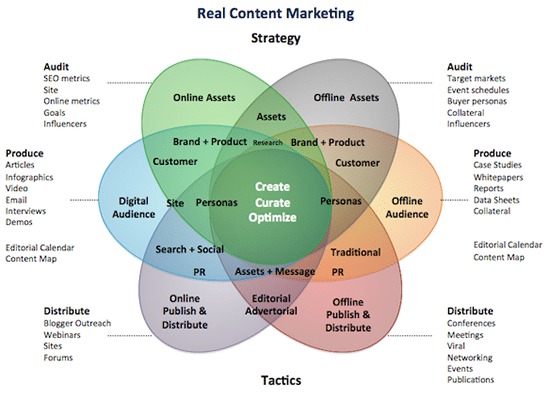What Is a Content Marketing Strategy?
In this article, we’ll explore what a content marketing strategy is, why it’s important, and how you can develop one that drives success.

In the digital age, where content is king, having a well-defined content marketing strategy is essential for businesses and creators aiming to stand out and achieve their goals. A content marketing strategy provides a roadmap for producing and managing content that attracts, engages, and retains a target audience.
Definition of Content Marketing Strategy
A content marketing strategy is a comprehensive plan that outlines how content will be used to achieve specific business objectives. It involves creating valuable, relevant content to attract and engage a target audience, ultimately driving actions that benefit the business, such as increasing brand awareness, generating leads, or boosting sales.
Importance: Without a clear strategy, content creation can become a disorganized effort, resulting in inconsistent messaging, wasted resources, and missed opportunities. A well-crafted strategy ensures that content efforts align with business goals and resonate with the intended audience.
Objectives of the Article
The goal of this article is to provide you with a clear understanding of what constitutes a content marketing strategy and how to develop one. Whether you’re a marketer, business owner, or content creator, this guide will help you create a strategy that drives results and maximizes the impact of your content.
Key Components of a Content Marketing Strategy
Business Goals and Objectives
Alignment with Business Goals
A successful content marketing strategy starts by aligning with your overall business goals. Identify what you want to achieve with your content, such as increasing brand awareness, driving website traffic, or generating leads. This alignment ensures that every piece of content contributes to your broader business objectives.
Specific Objectives
Set clear, measurable objectives for your content marketing efforts. For example:
- Brand Awareness: Increase social media followers by 20% in six months.
- Lead Generation: Generate 100 qualified leads per month through content offers.
Audience Research
Defining Your Target Audience
Understanding your audience is crucial for creating content that resonates with them. Use tools like surveys, social media analytics, and customer feedback to gather insights about your audience’s preferences, pain points, and behaviors.
Creating Buyer Personas
Develop detailed buyer personas to represent your ideal customers. These personas should include demographic information, interests, challenges, and content preferences. Buyer personas help tailor your content to meet the specific needs and interests of your audience.
Content Goals and KPIs
Setting Clear Goals
Define what you want your content to achieve. Goals might include increasing website traffic, improving engagement rates, or boosting conversions. Clear goals provide direction and help measure the success of your content marketing efforts.
Key Performance Indicators (KPIs)
Identify KPIs to track the performance of your content. Common KPIs include:
- Traffic Metrics: Page views, unique visitors.
- Engagement Metrics: Social shares, comments, time spent on page.
- Conversion Metrics: Click-through rates, lead generation, sales.
Content Planning and Creation
Content Types
Decide on the types of content that will best engage your audience. Options include:
- Blog Posts: Informative articles that provide value and drive traffic.
- Videos: Visual content that can be shared and engaged with on social media.
- Infographics: Visual representations of information that are easy to digest.
Content Calendar
Develop a content calendar to plan and schedule your content. A content calendar helps maintain consistency, ensures timely delivery, and aligns with key dates or events relevant to your audience.
Distribution Channels
Choosing Platforms
Select the platforms where your content will be published and promoted. Consider channels such as:
- Social Media: Platforms like Facebook, Twitter, LinkedIn, and Instagram.
- Email: Newsletters and email campaigns.
- Your Website: Blog sections, resource pages, landing pages.
Channel Strategy
Tailor your content to fit the characteristics and preferences of each distribution channel. For instance, use visual and concise content for social media, and more detailed, in-depth content for your blog.
Content Promotion and SEO
Promotion Techniques
Enhance the visibility of your content through various promotion techniques:
- Social Sharing: Share content on social media and encourage your audience to do the same.
- Paid Advertising: Use paid ads to boost content reach.
- Influencer Partnerships: Collaborate with influencers to amplify your content.
Search Engine Optimization (SEO)
Optimize your content for search engines to improve its visibility. This includes using relevant keywords, optimizing meta descriptions, and ensuring your content is valuable and relevant to your audience.
Measurement and Analytics
Tracking Performance
Utilize analytics tools to track the performance of your content. Tools like Google Analytics, social media insights, and email marketing platforms provide data on how well your content is performing.
Analyzing Data
Interpret the data to assess the effectiveness of your content strategy. Look at metrics such as engagement rates, conversion rates, and traffic sources to determine what’s working and where improvements are needed.
Developing a Content Marketing Strategy
Research and Discovery
Market Research
Conduct market research to understand industry trends, competitor strategies, and audience preferences. This research provides a foundation for developing a content strategy that stands out and addresses market needs.
Audience Insights
Gather insights into your audience’s behavior and preferences. Use this information to create content that resonates with them and addresses their pain points.
Strategy Formulation
Defining Goals and Objectives
Based on your research, set specific, measurable goals for your content marketing strategy. Clearly defined objectives provide a roadmap for your content creation and marketing efforts.
Creating a Content Plan
Develop a detailed content plan that includes content topics, formats, distribution channels, and a timeline. This plan will guide your content creation and ensure alignment with your goals.
Implementation
Content Creation
Produce high-quality, relevant content that aligns with your strategy and resonates with your audience. Focus on providing value and engaging your audience through compelling storytelling and useful information.
Distribution and Promotion
Execute your content strategy by publishing and promoting content across your chosen channels. Monitor performance and adjust your tactics as needed to maximize reach and impact.
Monitoring and Optimization
Performance Monitoring
Regularly review content performance using analytics tools. Track key metrics and assess how well your content is achieving your goals.
Continuous Improvement
Use performance data and audience feedback to refine and improve your content strategy. Make adjustments to content types, distribution methods, and promotion tactics based on what you learn.
Common Challenges and Solutions
Challenges in Content Marketing
Content Overload
Managing a high volume of content can be overwhelming. Ensure you have a structured content plan and use content management tools to stay organized.
Engagement Issues
Keeping the audience engaged can be challenging. Focus on creating high-quality, relevant content and use interactive elements like polls and quizzes to boost engagement.
Solutions and Best Practices
Effective Content Management
Utilize content management systems and tools to organize and streamline your content creation process. Regularly review and update your content to ensure it remains relevant and valuable.
Engagement Strategies
Implement strategies to increase audience interaction, such as responding to comments, encouraging feedback, and running engagement campaigns.
Examples of Successful Content Marketing Strategies
Industry Examples
Review case studies of successful content marketing strategies in various industries. Analyze how these strategies achieved their goals and the tactics they used.
Lessons Learned
Extract key takeaways and best practices from these examples to apply to your own content marketing efforts.
Tips from Experts
Insights
Seek advice from content marketing professionals and industry leaders. Learn from their experiences and apply their insights to enhance your content strategy.
Recap of Key Points
A content marketing strategy is a crucial tool for achieving business objectives through effective content creation and distribution. By understanding its key components and developing a well-defined plan, you can create content that drives results and builds strong connections with your audience.
Encouragement to Develop a Strategy
Start developing your content marketing strategy today. Apply the insights and strategies outlined in this article to create a plan that aligns with your goals and meets the needs of your audience.
Additional Resources
Further Reading
Explore books, articles, and guides on content marketing strategies for more in-depth knowledge.
Tools and Templates
Utilize tools and templates for content planning, creation, and management to streamline your efforts and enhance your strategy.
By following these guidelines and continuously refining your approach, you can build a successful content marketing strategy that drives engagement, grows your audience, and achieves your business objectives.
What's Your Reaction?






















